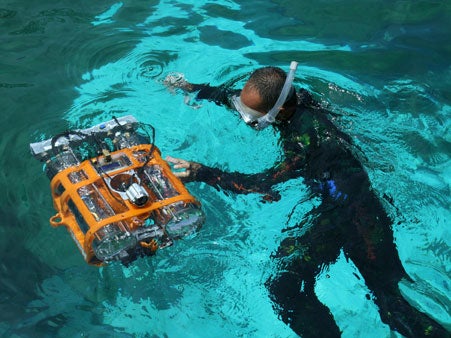Stray surface reflections confused the sensors on the IST/UCF Robot Club’s vehicle, spoiling the chance for a possible 2nd place finish during the Association for Unmanned Vehicle Systems International (AUVSI) Autonomous Underwater Vehicle Competition held in San Diego July 28 through August 2.
This latest competition was part of a series of Robotics Laboratory and Robotics Club events involving aerial, ground, surface and underwater vehicles. Thirty teams from five countries, including USA, South Korea, Japan, India and Canada, lined the underwater acoustic testing facility at the Space and Naval Warfare Systems Center.
UCF’s Robotics Club rounded out a satisfying season of competitions with a fourth place finish.
“Overall, we are happy about our performance at this event” said Daniel Barber, IST’s faculty advisor for the team and UCF Robotics Laboratory. “We learned new lessons that will lead to an improved performance next year.”
The UCF team (Jonathan Mohlenhoff is captain; other team members are Jacqueline Nelson, Gary Stein (graduate advisor), Cassondra Puklavage and David Adams) ran into some serious camera failures due to water leakage on the first day in San Diego. Replacement underwater cameras also leaked, requiring emergency silicone treatment. In spite of these setbacks, the team qualified for the finals and ultimately garnered the fourth place finish.
“Autonomous” means everything the vehicle needs to perform a task relies on on-board sensors and computer programs. No radio control can be used to help the vehicle, in this case a submersible, complete its task.
Each team’s underwater vehicle first had to qualify by maneuvering through an underwater gate. A series of tasks required the vehicle to find a buoy, shoot a missile at a target, drop depth charges, travel under “barbed wire,” retrieve a suitcase and surface in a prescribed location. Cornell University’s submersible completed the most of these various tasks, gaining the competition’s top honors.
“The Robotics Club has had a fantastic year,” said Barber, “3rd place at IEEE SoutheastCon, 1st place at the Autonomous Surface Vehicle Competition, and 4th at the AUVC. These activities are the best way to get students interested in engineering and computer science and working in a team, giving them the opportunity to apply what they’ve learned in the classroom. “When they enter the workforce they can begin contributing to advanced projects immediately.”
